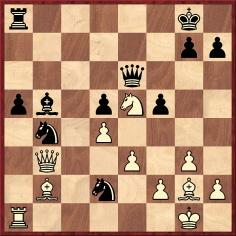
Edward Winter
In the BBC-1 television programme Mastermind International transmitted on 3 June [1982], the New Zealand contestant John Clarke answered questions on the History of Chess. Few were easy. Do you know how many competitors there were in the 1939 Women’s World Championship tournament? Another question asked for the name of either of the two masters who beat all four world champions from Steinitz to Alekhine. Is it a self-delusion if we claim to have been the first to point out the feat of Janowsky and Tarrasch, in the magazine CHESS, October 1976?
(150)
The Mastermind International question about the 1939 Women’s World Championship was also mentioned in C.N. 9476, where we commented:
See too page 346 of the August 1982 BCM. Mr Clarke could hardly be blamed for not knowing the answer; contestants hoping to demonstrate their ability to retain, or inability to shed, information are at the mercy of question-setters, who may be ill-equipped for the task.
Note: the above two items were added here on 15 July 2025.
A position to ponder:

Three posers:
a) White to move and win. b) Where has this position been widely seen? c) Where has it been printed before?
(1497)
a) The winning combination is easy enough: 1 Qxb4 axb4 2 Rxa8+ Be8 3 Bxd5.b) The position was played out in an episode of the NBC television series Columbo in which the world chess champion murdered his closest rival.
c) It is given, for instance, on pages 168-169 of Winning Chess by Irving Chernev and Fred Reinfeld (New York, 1948).
(1577)
Congratulations to Jack O’Keefe (Ann Arbor, MI, USA), who has discovered that the position did come from a real game:
W.J. Wolthuis – Conel Hugh O’Donel Alexander1 d4 Nf6 2 c4 e6 3 Nc3 Bb4 4 Qc2 Nc6 5 Nf3 d6 6 a3 Bxc3 7 Qxc3 O-O 8 g3 Ne4 9 Qc2 f5 10 Bg2 Qf6 11 e3 Bd7 12 b4 a5 13 b5 Ne7 14 Bb2 c6 15 a4 Rfc8 16 bxc6 Nxc6 17 O-O Nb4 18 Qb3 d5 19 cxd5 exd5 20 Rfc1 Rxc1+ 21 Rxc1 b5 22 axb5 Bxb5 23 Ne5 Qe6 24 Ra1 Nd2 25 Qxb4 Resigns.
The poser position was also used in a ‘Chess Quiz’ on page 21 of the June 1948 issue of Chess Review.
(1666)
René Olthof (Rosmalen, the Netherlands) sends us a copy of an article on pages 144-145 of the 7/1988 issue of the Danish magazine Skakbladet, an article by Bent Kølvig on chess positions which have appeared in films or television programmes. The one given in C.N. 1497 (see above) is included, though without reference to the Wolthuis v Alexander game.
(1726)
Regarding Wolthuis, see C.N. 6347.
A picture of Peter Falk with Yasser Seirawan (as well as Larry Christiansen) appeared on the front cover of the December 1983 Chess Life:
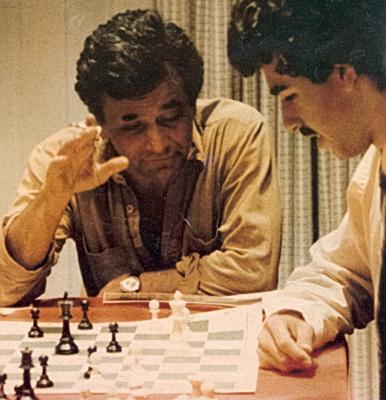
(6347)
The cover also had a smaller photograph of Falk in conversation with Korchnoi:
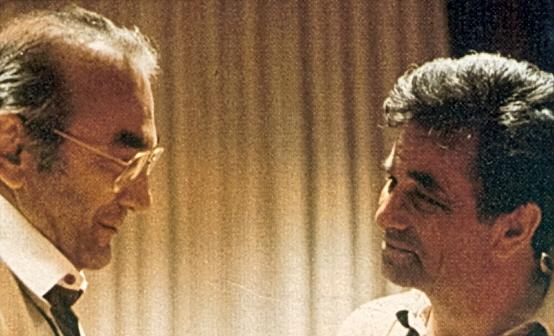
That issue of the magazine (page 33) had a further photograph, whose caption stated that the actor was ‘a frequent spectator in Pasadena’:
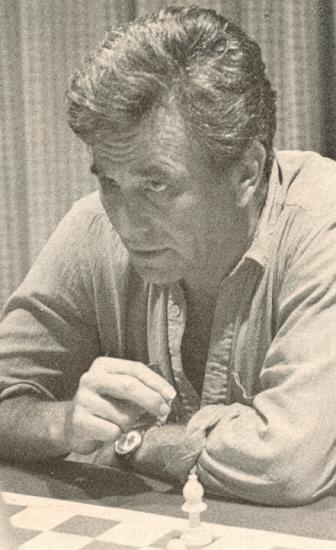
Page 71 of the February 1973 Chess Life & Review had a shot of Falk with an unidentified player at the Eighth American Open, Santa Monica, 1972:
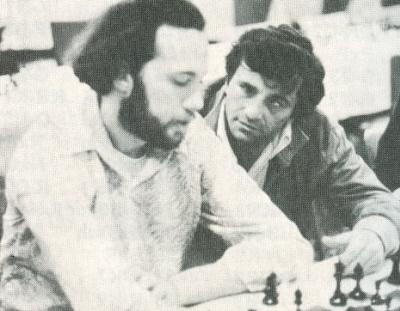
(6848)
John Donaldson (Berkeley, CA, USA) and Charles Sullivan (Davis, CA, USA) inform us that the player with Peter Falk who was left unidentified by Chess Life & Review is Dennis Waterman. Our correspondents note that he is now a well-known poker player, and Mr Donaldson adds:
‘Waterman gave Peter Falk lessons in the early 1970s. He played in the first Lone Pine tournaments but gave up chess in the early 1980s.’
(6855)
See too our comments about Columbo in Chess and Hollywood.
Also regarding the Columbo chess episode, The Most Dangerous Match, C.N. 1577 reported:
The plot of the television programme is slated by Sylvain Zinser on page 56 of the March 1988 Europe Echecs.
In the simultaneous display scene towards the end of the episode, the murderer, played by Laurence Harvey, mentioned Alekhine, Capablanca, Marshall and Nimzowitsch.
An extract from C.N. 1387, written in 1987 (see Rebuttals):
The BCM is even capable of dropping a news story half way through if it looks likely to show Mr Keene in unfavourable light. The most recent example concerns a court writ (behind which was Raymond Keene and Thames Television) issued in February against Aly Amin of Chequers. Mr Amin was prevented by the subsequent High Court hearing from bringing out a book on the Kasparov-Short speed chess event until the recordings of all six games had been shown on television. One can appreciate the reasoning behind such a restriction, which aimed to ensure that the suspense of the match was not spoiled for viewers. The BCM clearly considered the story an important one, even discussing it in its March editorial. Its April issue quoted a Thames Television spokesman’s comment on the High Court verdict: ‘This is a significant victory which safeguards delayed transmission of chess on television and will enable us to explore future similar projects’. So far, so good. But on 16 March Mr Keene’s own book on the match was rushed out early. At that time two games had still not been screened, and viewers’ interest was therefore well and truly spoiled – by the very parties who had used the courts to stop Aly Amin from doing the same. So did the fearless BCM draw attention to this hypocrisy? Not at all. The May issue (page 194) reviewed the Keene book – uncritically, of course – but the legal dispute, extensively reported up until then, was quietly dropped.
Roger Lancaster of Chequers, London sends us a copy of a letter written by him to news flash giving further details of the legal dispute regarding books on the Kasparov v Short match. Since the full text is published on page 10 of the 10 July 1987 news flash we give just a brief summary here. On 10 February M.J. Feldman, a Thames Television producer, made an affidavit: “... it was critical that the results and in particular the moves made by the players were not published until each game had been transmitted in order not to spoil the viewers’ interest and enjoyment of the programmes. ... In an accompanying affidavit, Raymond Keene swore that he agreed with Mr Feldman’s statement. However, a copy of Mr Keene’s Batsford/Thames book was in the hands of Chequers’ solicitors when only three of the six match-games had been transmitted. Mr Lancaster puts the central point very well:
‘It will be interesting to know, and indeed the High Court may wish to know, how Messrs Feldman and Keene reasoned that a book written by an outside party would “spoil the viewers’ interest and enjoyment” while a book co-produced by Thames Television and written by Keene would not.’
(1452)
Wanted: specific information on how the court case ended.
The Swiss programme mentioned in C.N. 1594 (see Fast Chess) was one of a fine series scheduled throughout the annual Biel festivities. It is a pity that French television, in one of its rare acknowledgements that chess exists, recently failed badly on a major occasion. The coverage by TF1 of Kasparov’s simultaneous display by satellite at Cannes was a riot of muffs and fluffs fronted by a kind clot who smiled boyishly while mistranslating most of what Kasparov said. Pin-ball looked more his game. The ten battles over the chessboard were largely ignored, and few of the opponents were even named. What little dignity the broadcast retained was due to Nicolas Giffard and Kasparov himself.
Perhaps one sometimes needs to campaign against television coverage of chess, if publicizing means vulgarizing. A final thought: when chess publicists/vulgarists in Britain express the hope that the game will ‘take off’ like snooker, they forget that chess is already ahead in terms of television coverage almost everywhere in the world.
(1595)
From a report by Harry Golombek on the seventh game of the Botvinnik v Smyslov world championship match in Moscow on 30 March 1954:
‘Television made its first appearance in the history of world chess championship matches during the course of this game, which was televised from 8 till 8.30 p.m.’
Source: BCM, May 1954, page 141.
(2655)
From CHESS, July 1972, page 299:
‘A chess programme in colour of 30 minutes’ duration has been recorded for television cassettes on a co-production basis between the Crown Television Group London and East End Productions in New York. It is based on Harry Golombek’s Penguin book The Game of Chess.’
(2787)
In the half-hour television programme Chess in Pieces (BBC Four, 7 July 2003) an assortment of unprepossessing chessists and actressy artists waffled on inconsequentially within an over-blown, under-researched narrative. ‘Lenin declared that chess was the gymnasium of the mind’, intoned the voice-over, although that well-known phrase dates back to 1803 (Studies of Chess). The viewing hundreds were also informed that chess ‘began in Persia around 7 AD’ and were left to conclude that the game’s history ceased in 1972, after a Spassky-Fischer match which ‘lasted three months’. The existence of Karpov and Kasparov was left undisclosed. Capablanca and other notables were visible for a few seconds, without the courtesy of identification. There was, however, a caption for the programme’s advisor, Gareth Williams, who was also billed for his big day as ‘a leading author and chess historian’.
(2987)
On 7 February 2005 the UK television programme Mind Games (BBC Four) had William Hartston as a guest contestant. He was in fine form in the face of a thorny set of braintwisters. For instance, cuboid is a three-dimensional shape with six faces but also a word with six letters, and the teams were required to name another three-dimensional shape with the same number of faces as letters. It was Hartston who supplied the answer: dodecahedron (12 faces, 12 letters).
When he last did chess on television we do not know, but he is certainly the best presenter of the game we have seen.
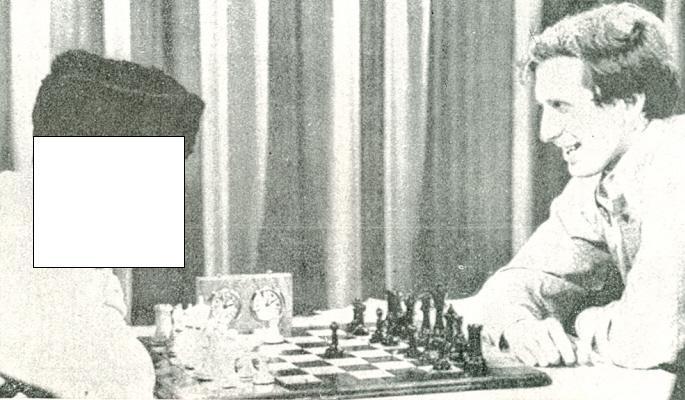
Readers are invited to identify the person with whom Fischer is, to borrow a mouldy expression favoured by captionists, ‘sharing a joke’.
(5065)
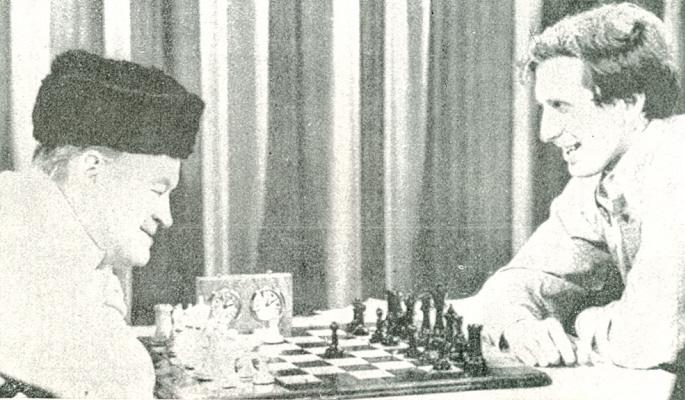
Bobby Fischer is at the board with Bob Hope (1903-2003) in a photograph on page 291 of a book on the 1972 Spassky v Fischer match, Campeonato del mundo (San Sebastián, 1972). An advertisement for the television programme appeared, inter alia, on pages 78-79 of CHESS, December 1972:
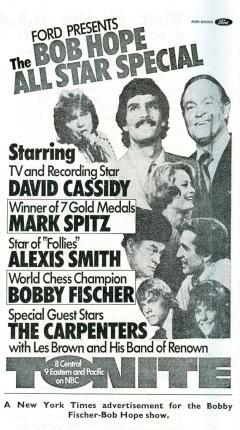
A recording of Fischer’s performance is commercially available.
From Fischer’s guest appearance in autumn 1972 on The Bob Hope Special television show, which also starred Mark Spitz, we have made three stills:
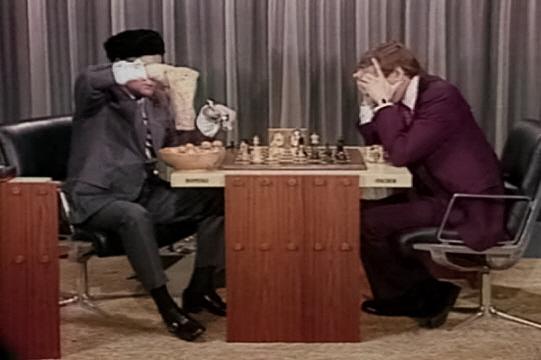
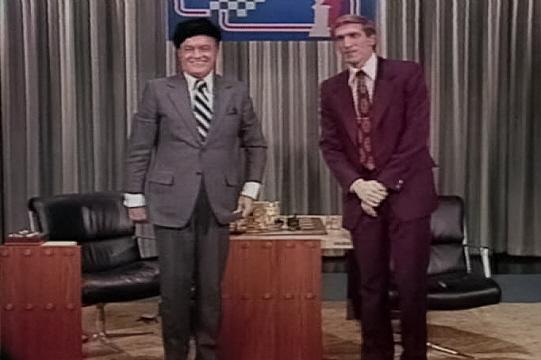
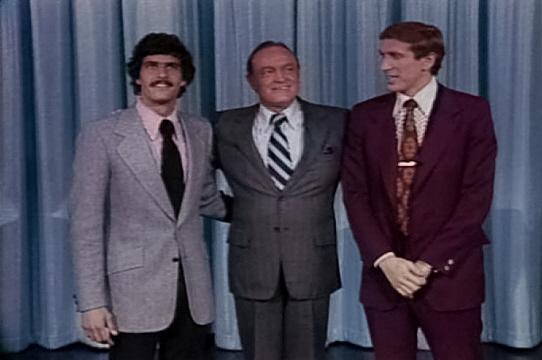
In the early part of the programme Bob Hope (‘Hopeski’) was shown enduring a lonely wait at the board. The world champion’s eventual arrival led into some rather wooden banter (naturally covering such topics as unpunctuality, cameras, noise and money), whereafter the comedian played 1 c4 and won a top-speed game during which he muddled chess and checkers and elicited the loudest possible racket from a bag of nuts.
Although the cue-cards were successfully kept off-camera, the production and editing were choppy, with, even, Hopeski’s king and queen switching places between two shots at the start of the game. The sketch lasted six minutes. Fischer received a very warm reception, although not the standing ovation accorded to Mark Spitz.
(5094)

This photograph features Dorothy Tutin and Clive Swift in Willow Cabins, a play written by Alan Plater, directed by David Cunliffe, produced by Yorkshire Television and broadcast on 1 December 1975. We culled the picture from page 11 of TV Times, 29 November-5 December 1975, where it accompanied an article, ‘Chessbored’, by Paul Jennings.
(5236)
Larry Crawford (Milford, CT, USA) draws attention to a webpage presenting the chess set of Robert E. Lee.
C.N. 3043 (see page 101 of Chess Facts and Fables) mentioned that in his 1970s television series America (the episode entitled ‘A Firebell in the Night’) Alistair Cooke visited the Curtis-Lee Mansion, Arlington and showed the travel set.
(5508)
Following the death of Sir Clement Freud on 15 April 2009, we reproduce a photograph from page 121 of CHESS, January 1973:
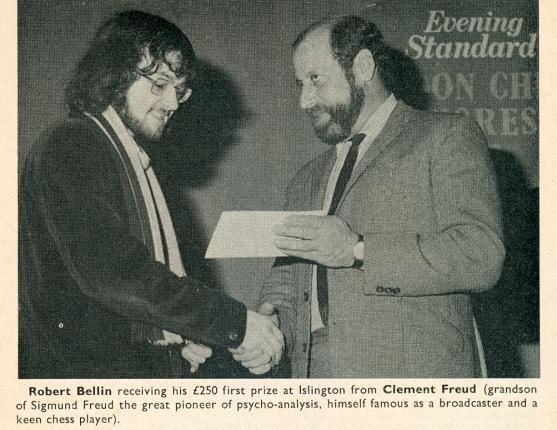
(6081)
The US actress Beatrice Arthur, who died on 25 April 2009, starred in NBC’s The Golden Girls (1985-92), one of the most successful of all situation comedies. Two episodes had scenes featuring a game of chess: ‘There Goes the Bride’ (part one) and ‘Henny Penny – Straight, No Chaser’.
(6095)
Concerning Isaac Kashdan’s appearance on the television show You Bet Your Life, presented by Groucho Marx, Gene Gnandt (Houston, TX, USA) points out that the segment can be viewed on YouTube. It is also available on a ‘14 Classic Episodes’ DVD.
[Addition on 6 May 2011: the YouTube link no longer works, but in C.N. 7072 Mr Gnandt gave a replacement link, to the Internet Archive.]
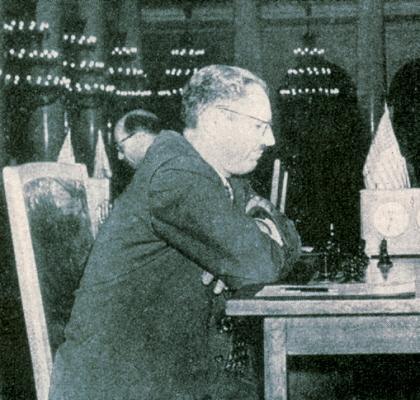
Isaac Kashdan
(6180)
Chess is frequently visible in television drama but seldom becomes a central theme. An exception is the episode ‘Hartsfield’s Landing’ in season three of the US series The West Wing, which even contained extensive discussion of the history of the game.
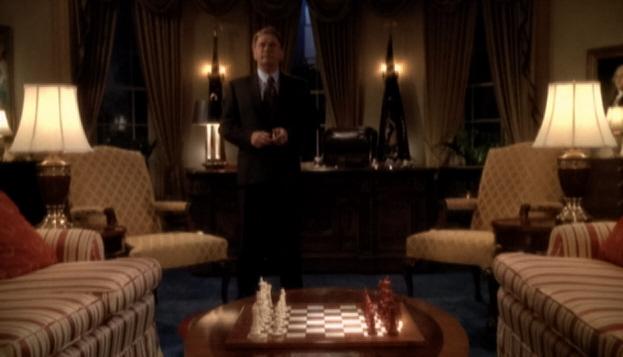
In the above freeze-frame President Bartlet (Martin Sheen) is in the Oval Office with one of the chess sets which he has brought back from India. During the episode he plays games against two staff members, Sam Seaborn (Rob Lowe) and Toby Ziegler (Richard Schiff), defeating both.
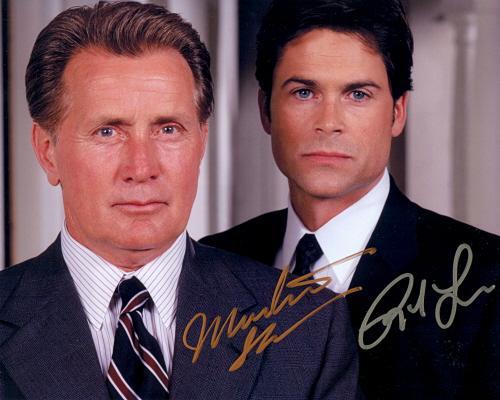
Martin Sheen and Rob Lowe
(6192)

Martin Sheen has stated: ‘I don’t play chess.’ Source: page 47 of The West Wing created by Aaron Sorkin (London, 2002).
From pages 70-71 of Play All by Clive James (New Haven and London, 2016):
‘In The West Wing the purity of language is unreal: network rules prevail and we never hear a dirty word. Nor does anyone, not even a writer, ever really talk that well. But there is realism about the way reasoned conclusions are reached.
In that regard, the most advanced stroke of realism in the show is the way that not even the brilliant Bartlet can function without hearing other voices. Those of us who hanker for a father figure should remember that if he existed then he would need a father figure too. Though Bartlet is a mighty chess player, The West Wing is a pretty good shot at fighting off the romanticism by which the central guru can understand the whole board at a glance. In I, Claudius Augustus sometimes didn’t know what was really going on, but he didn’t know that he didn’t know. Bartlet incarnates Camus’s definition of democracy as the system built and maintained by those who know that they don’t know everything.’
See too Clive James and Chess.
Below from our collection is a photograph signed by cast members of The West Wing in 2002:
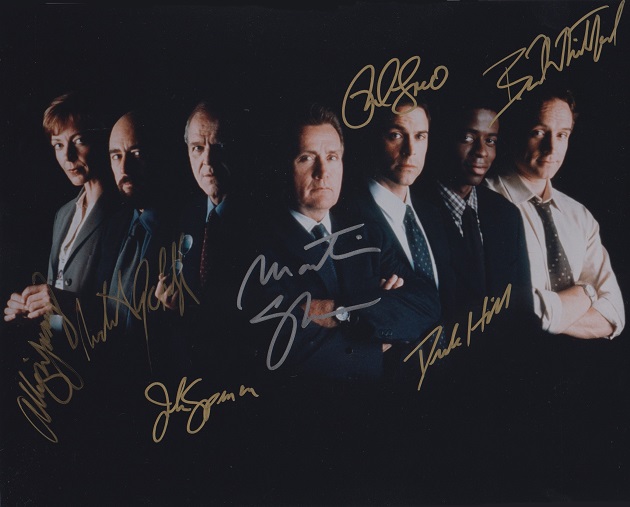
Left to right: Allison Janney,
Richard Schiff, John Spencer, Martin Sheen, Rob Lowe, Dulé Hill
and Bradley Whitford.
(10168)
Miss Fatima was interviewed about Sultan Khan in the Bandung Limited television production The Sultan of Chess broadcast by Channel 4 in the United Kingdom on 19 September 1990. She mentioned that she had given some chess instruction to Queen Mary, the wife of George V.
(6201)
Serin Marshall (Brooklyn, NY, USA) asks whether any recordings have survived of Shelby Lyman’s television programmes on the 1972 world championship match.

(6464)
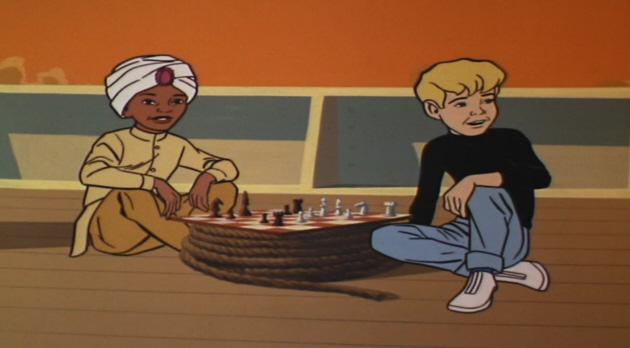
Few animated series have featured chess, but the above shot, showing Hadji and Jonny Quest, comes from ‘Dragons of Ashida’, an episode in the US production Jonny Quest (first broadcast in 1964-65).
At the start of another episode, ‘Attack of the Tree People’, Dr Benton Quest was playing chess with Race Bannon, while Jonny Quest and Hadji played checkers.
(6746)
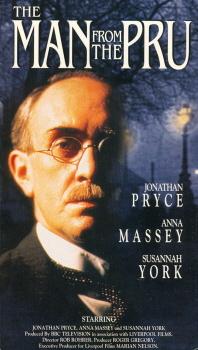
The Man from the Pru (BBC, 1989)
See Chess and the Wallace Murder Case.
A spoof feature on page 67 of Punch, 14-20 January 1970:
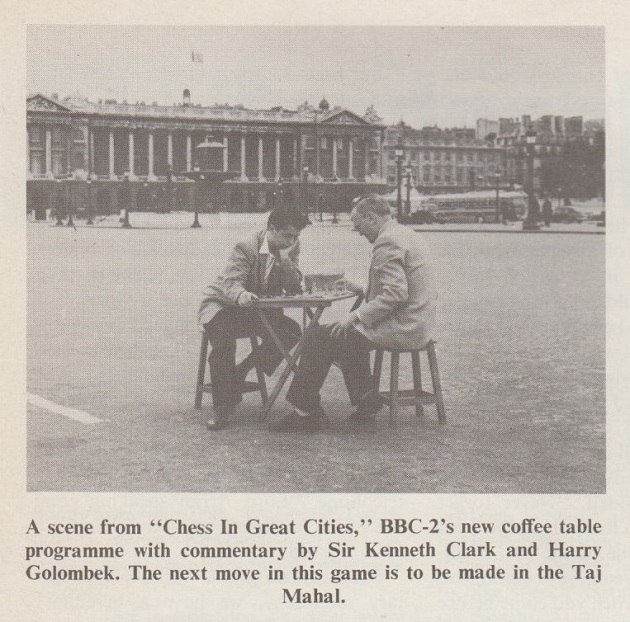
(9106)
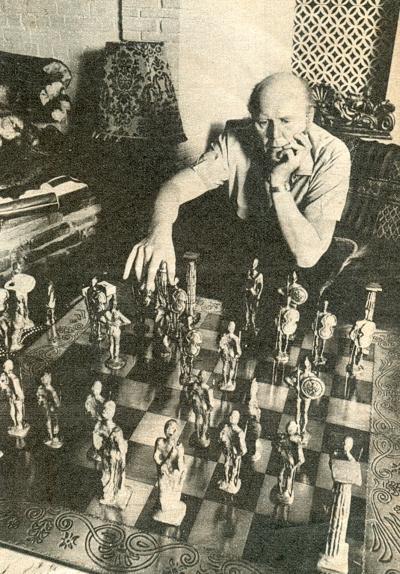
David Nixon
The above photograph appeared in the article ‘Not magic, just a small case of cheating’ by Alix Coleman on pages 21-22 of TV Times, 29 March-4 April 1975. The article marked the imminent start of the television series Playing Chess. Details of the 13 programmes, together with a photograph of David Nixon and Bob Wade in the studio, were given on pages 129-131 of the April 1975 BCM.
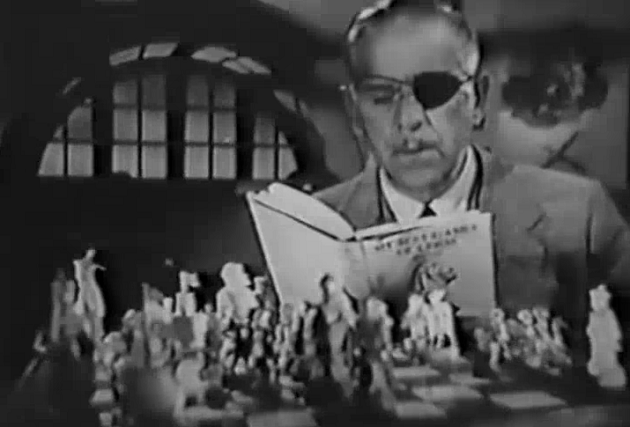
This screen-shot has been provided by Alan O’Brien (Mitcham, England) from the 1956 television programme Colonel March of Scotland Yard: The New Invisible Man. The episode can be viewed on-line, and the shot of Boris Karloff holding a chess book (which, our correspondent notes, appears to be My Best Games of Chess with the standard dust-jacket of Bell chess books), occurs at about 14’40”.
(10055)
A reference to chess by the brilliant BBC broadcaster Eddie Mair.
(10792)
Eddie Mair, primarily a radio broadcaster, left the BBC to join
LBC in 2018. His final LBC broadcast was on 18 August 2022.
Books by which chess author appear in both Endeavour (Shaun Evans) and Poirot (David Suchet)?
The answer is below. (The episodes of these ITV programmes were entitled, respectively, ‘Game’ and ‘The Big Four’.)
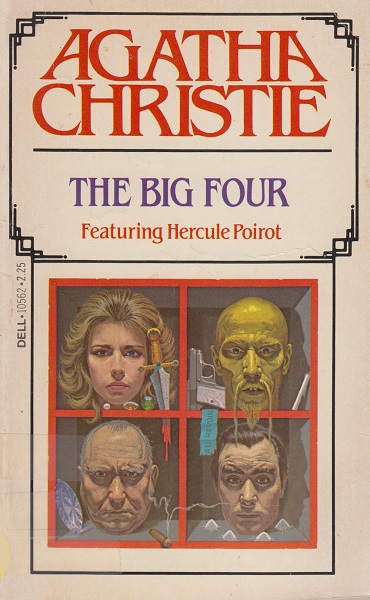
The answer is E.E. Cunnington (1852-1942).
Near the beginning of the Endeavour episode, the eponymous detective briefly handled a copy of Chess Lessons for Beginners:
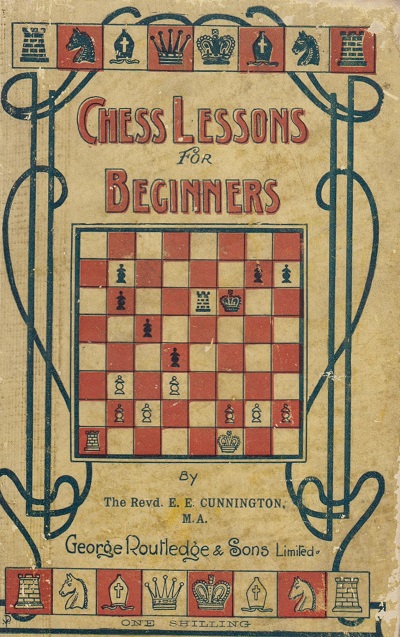
‘The Big Four’ has a short scene, also early on, in which Hercule Poirot was researching the Ruy López in a large-format book with a fictitious cover and title (The 50 Greatest Chess Problems – author’s name indistinct). The content fleetingly shown is identifiable as being from Cunnington’s Chess Traps and Stratagems.

Below are the pages from which fragments of text and diagrams can be seen, just about, in ‘The Big Four’, although the lay-out was altered:
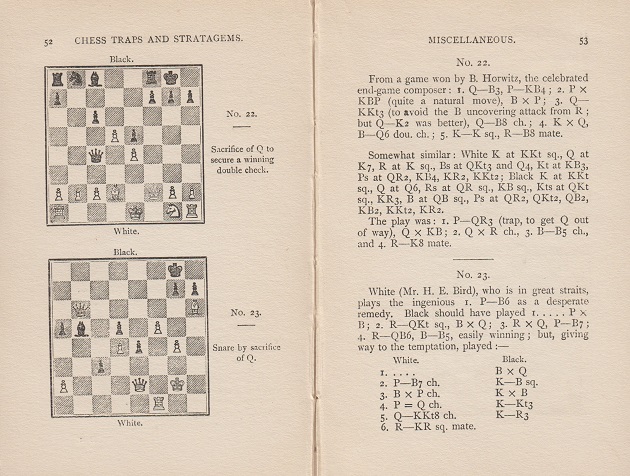
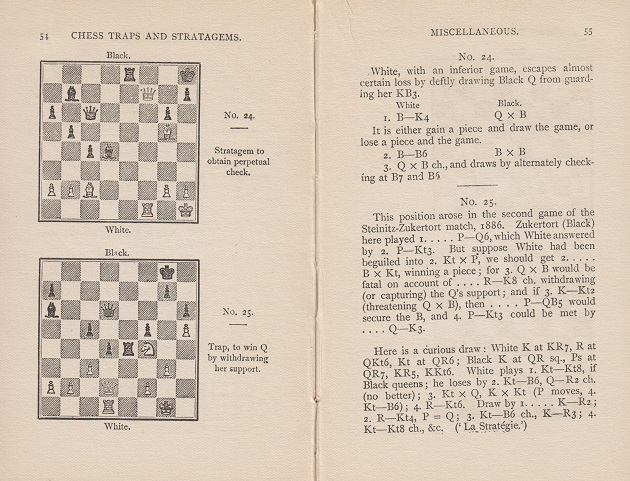
(11057)
Three of Alan Bennett’s Talking Heads monologues (BBC television) contain references to chess: ‘A Chip in the Sugar’ (1988), ‘Her Big Chance’ (1988) and ‘Miss Fozzard Finds Her Feet’ (1998). The episodes were re-made by the BBC in 2020.
A programme not yet mentioned is Kings of the Castle, narrated by Paul Jennings, produced by Robert Toner and broadcast on BBC-2 on 22 July 1978. We have this BBC Enterprises flyer:
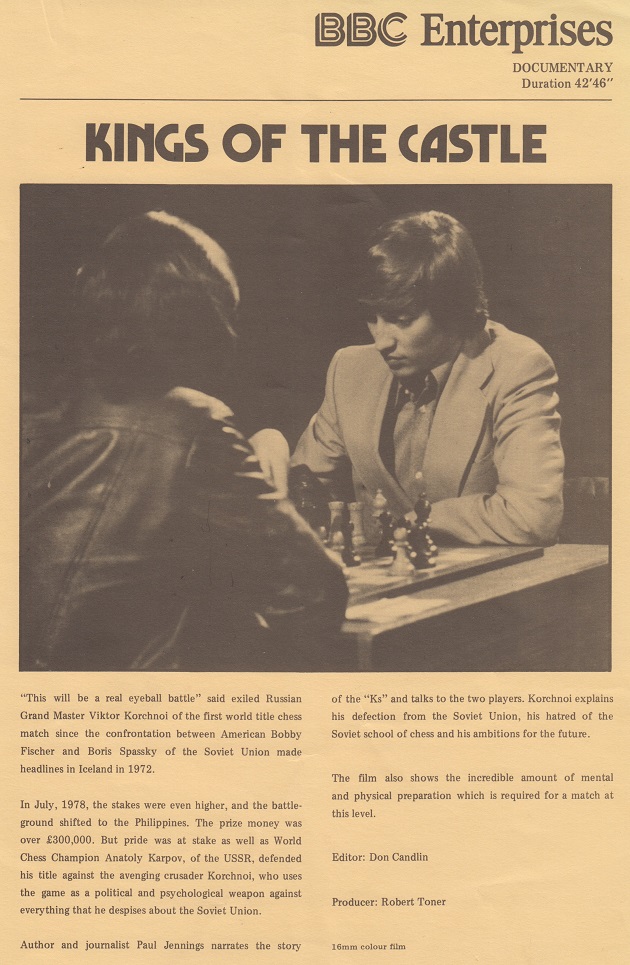
Three years later, on 3 October 1981, a documentary of the same title was transmitted by BBC-2 ahead of the world championship match in Merano.
(11825)
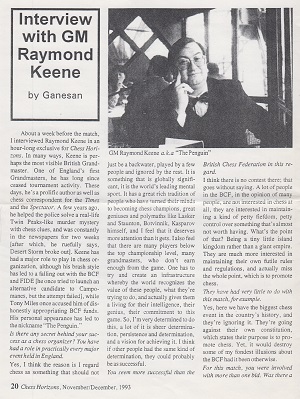
Pages 20-24 of Chess Horizons, November/December 1993 had an interview with Raymond Keene by Ganesan conducted about a week before the start of the Kasparov-Short match in London. On page 21 Raymond Keene discussed the projected television coverage of the match in the United Kingdom:
‘If you look now, we’ve actually achieved a guaranteed total of 77 hours on BBC, Channel 4, and Sky TV covering the match which is a world record for chess coverage. If you compare it to the amount of coverage for the Olympic Games, which is 135 hours, it’s more than half that. That is extraordinary. I told them it would be big but it’s unbelievably big, the amount of TV coverage. 77 hours before it even starts, and that’s not counting news coverage. Almost every newspaper has something about chess. It’s going to get bigger and bigger and bigger, and this is just the tip of the iceberg. It’s a total vindication of the magnitude of the match. I think I can already guarantee that this match will have got more publicity than any other in the history of chess. If you take the TV coverage into account, I would say this match already has more coverage than all the previous matches put together.’
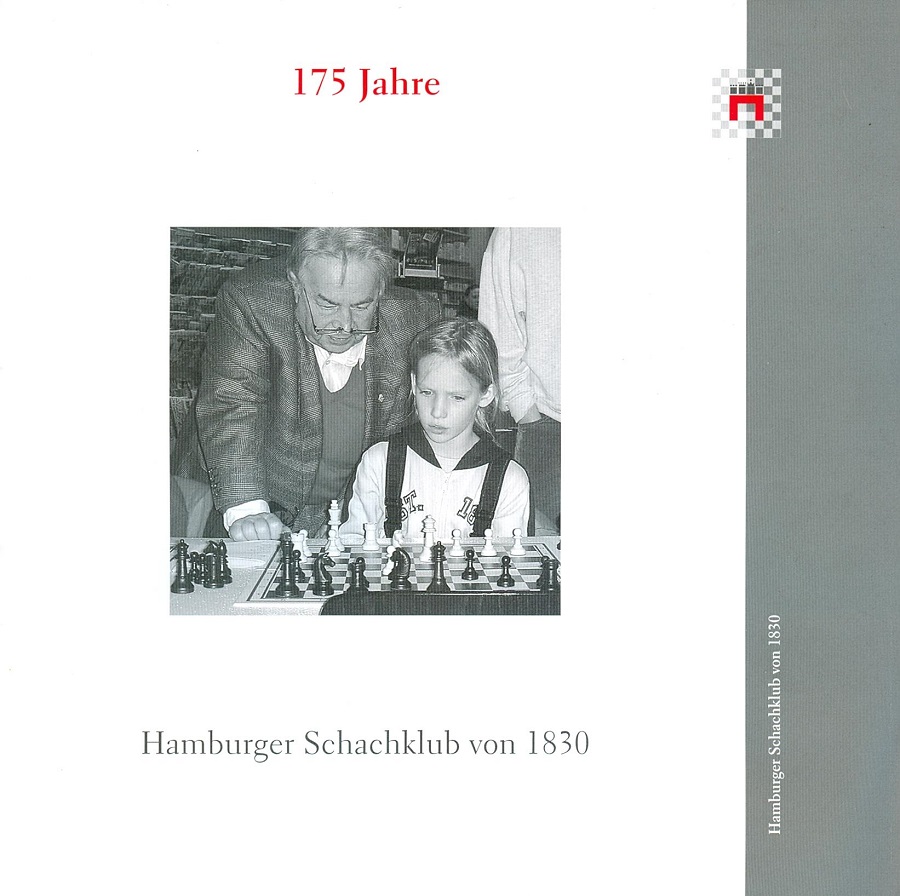
This front-cover photograph features Christian Zickelbein and not, as might be imagined, Leo McKern, the actor who played Horace Rumpole in Rumpole of the Bailey.
The first episode of a new PBS television series, Today in Chess, refers to ‘the chess capital of the US, Saint Louis, Missouri’. Through the munificence of Rex Sinquefield, the Saint Louis Chess Club is often described, without contradiction, as the greatest chess club in the United States. What comparable chess clubs (whether in terms of premises, opulence, membership, activity or any further criteria) exist in other countries? In short, if the Saint Louis Chess Club were described as the greatest in the world, would any clubs have a legitimate grievance?
This photograph of the Saint Louis Chess Club was taken for us on 12 February 2024 by Yasser Seirawan:
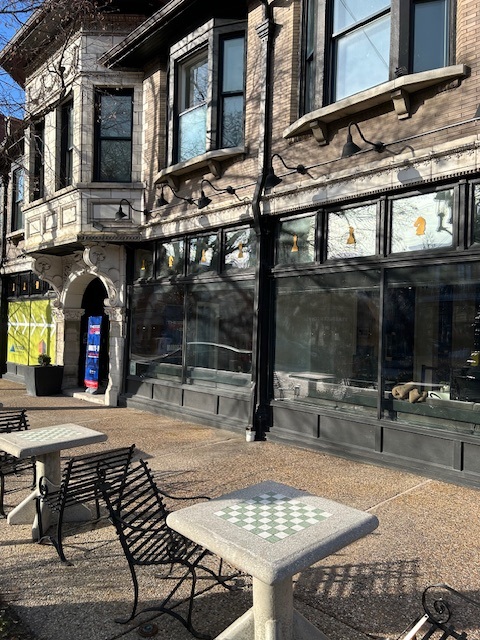
(11980)
Addition on 28 February 2025:
Boris Spassky’s fame was such that he was even mentioned by Alf Garnett in an episode of the BBC-1 television programme Till Death Us Do Part written by Johnny Speight and broadcast on 28 February 1974 (link: starting at about 16:06).
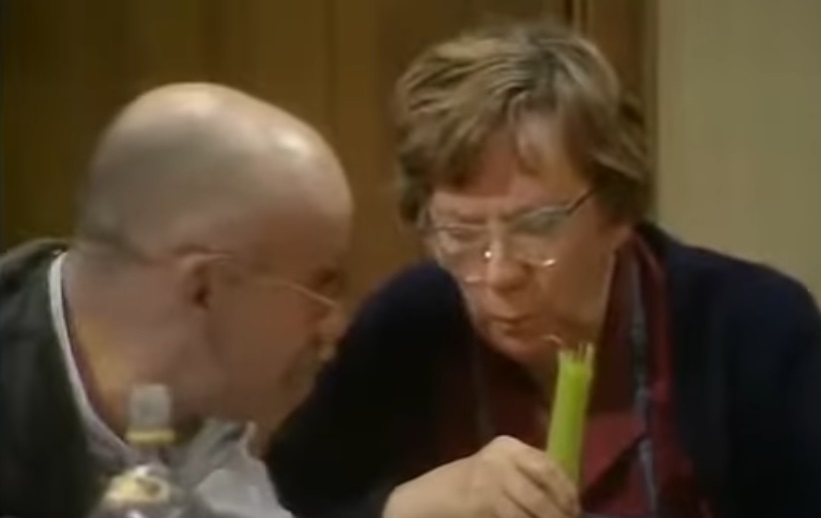
Addition on 18 May 2025:
The Fool’s mate is mentioned and shown in an episode of the television series Heartbeat, entitled ‘The Buxton Defence’, first broadcast in the United Kingdom on 1 April 2001. In a simultaneous display, the Russian champion Leonid Vorodin (Jalaal Hartley) mated Oscar Blaketon (Derek Fowlds) in three moves. The full episode, with a chess theme, is available on YouTube, and the Fool’s mate game begins at 17:05 and ends at 17:25.
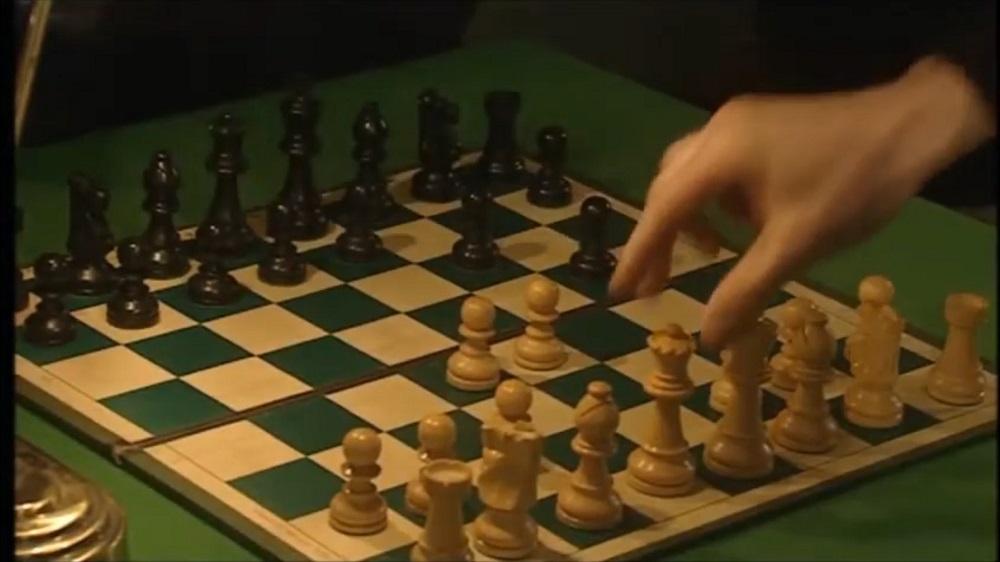
See also Fool’s Mate.
Page 273 of the Moscow, 1936 chapter of our monograph on Capablanca (see C.N. 12156) states, ‘Thus Capablanca revenged his 1935 loss to Lasker in Moscow’. Although this transitive use of ‘to revenge’ is recognized by the Oxford English Dictionary, the more usual verb ‘to avenge’ is surely better.
Mention of avenging prompts us to recall that chess was occasionally depicted in The Avengers, a British television series in the 1960s. The chessiest episode was ‘Room Without a View’, set in the Chessman Hotel and first broadcast on 8 January 1966:

Peter Arne and Patrick Macnee
The following image is shown with permission from the Hulton Archive:
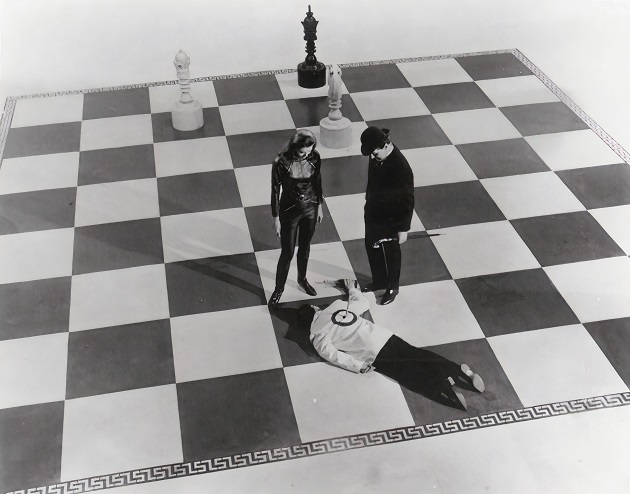
Emma Peel (Diana Rigg) and John Steed (Patrick Macnee)
This relates to a brief introductory film sequence for the US market. See also page 136 of The Ultimate Avengers by Dave Rogers (London, 1995) and an extensive Avengers website.
(12164)
To the Chess Notes main page.
To the Archives for other feature articles.
Copyright: Edward Winter. All rights reserved.